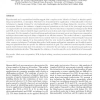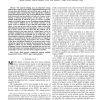1313 search results - page 253 / 263 » Dimensionality Reduction for Classification |
IJON
2007
13 years 9 months ago
2007
Experimental and computational studies suggest that complex motor behavior is based on simpler spatiotemporal primitives, or synergies. This has been demonstrated by application o...
ISCI
2007
13 years 9 months ago
2007
: In our book to appear in print from Springer-Verlag GmbH, Simulating Continuous Fuzzy Systems, Buckley and Jowers, we use crisp continuous simulation under Matlab™/Simulink™ ...
TSP
2008
13 years 9 months ago
2008
The rapid developing area of compressed sensing suggests that a sparse vector lying in a high dimensional space can be accurately and efficiently recovered from only a small set of...
CVIU
2007
13 years 9 months ago
2007
The problem of face detection remains challenging because faces are non-rigid objects that have a high degree of variability with respect to head rotation, illumination, facial ex...
CIKM
2010
Springer
13 years 8 months ago
2010
Springer
Low-dimensional topic models have been proven very useful for modeling a large corpus of documents that share a relatively small number of topics. Dimensionality reduction tools s...



